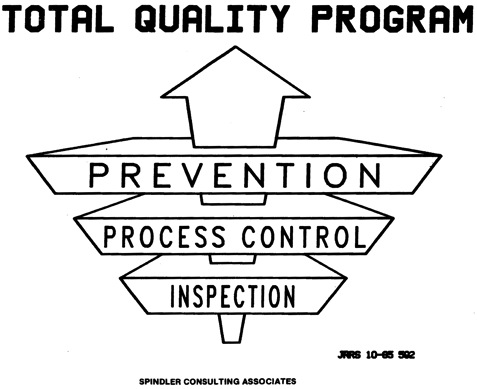As shown in the figure, we can describe three possible levels of this state of mind, Inspection, Process Control, and Prevention.
Inspection stage
In this most concrete thinking state, "Inspection," we tend to think in a reactive way. The focus is on highly visible flaws that have already occurred. We check to see if there is a problem and if so, correct it. Typically we inspect product or work looking for errors and deficiencies. Then we correct the error or remove the deficiency and proceed.
“Systems thinking” – mentally visualizing everything as a system where a change in one parameter gets a result elsewhere – is generally not part of the inspection stage. People functioning at this stage generally do not participate in “statistical thinking” – the idea that variation is an inherent part of all data. Fundamentally, most members of the organization expect problems – problems are inevitable, part of ‘the world.’
Some businesses, especially small “mom and pop” businesses, never get out of this Inspection mode. It is reflected in everything they do whether it be making a product, accounting, or designing products. Constant engineering changes are a telltale indicator of this level of the Inspection stage. Since problems are believed inevitable, the best response is expeditious correction.
It is very comfortable to correct problems exactly because they are familiar; each problem corrected reinforces the personal feeling of competence and capability. Unfortunately, reacting to these familiar problems can take up all the intellectual energy of the people involved, preventing any reduction of problem frequency.
Process Control stage
As we mature and get a bit smarter, we may say to ourselves, "I keep making the same mistakes. Maybe, the process is the problem. If I correct the process, I will not keep turning out a defective product or an inferior service." This thinking marks the "Process Control" phase. It means that we find the weak processes – whether they are manufacturing, design, accounting, or other processes – then fix and control them so that they do not go astray.
“Statistical thinking,” and “systems thinking” are usually implicit in discussions of problems and solutions. SPC, other statistical tests, preventive maintenance, documentation, and training are all possible actions undertaken with the intent of improving the consistency and performance of the processes. Achieving the process control stage of thinking involves a paradigm shift among many people in a company – the problems are no longer inevitable, but can be addressed and removed. Individuals who do not participate in the new conceptualization often have difficulty understanding the rest of the discussion.
US companies today tend to be entering or well into the process control stage of thinking. Here we identify poor process behavior, do root cause analysis and correction, and take whatever action is needed to keep the process on track. This is all driven by the mode of thinking – the use – of the tools. Often we presume the process is effective in principle while we believe the execution contains the flaws.
The “comfortable feeling” gained from this effort is great in the long term, but improvement is not visible until the improved process has been used for a time. Frequently only those who understand the charts and records recognize how much improvement has been obtained. Also, some people may feel a sense of loss when the repetitive problems no longer arise; they feel less needed and may not recognize the major contribution they can make at the process control stage.
Prevention stage
If an organization or an individual continues to mature, they begin to recognize that if they think ahead, reason analytically, and do some risk assessment, they often can discover that the process or product design has flaws that will cause problems if the process is implemented. Then, by correcting the deficiency before implementing the process, they can prevent the potential problem from ever occurring. Clearly, thinking of everything as a system and recognizing the statistical nature of all data are pre-requisites to functioning at this level. When the organization and individuals start routinely thinking and acting in this very proactive way, they have graduated into the third level, "Prevention" stage.
The “comfortable feeling” from this work is more removed from daily operations than in the Process Control stage. Communicating specific accomplishments to management and others is more difficult because the potentially visible problems rarely occur. Production operations, and everything that depends on them, run more smoothly than ever before. People who love to demonstrate their crisis-handling abilities have fewer crises to handle.
Implications of the three levels of “quality” thinking.
External threats, such as an impending work force reduction or a threatened corporate take-over, seem to discourage the systems thinking necessary for continued improvement. Some companies regress when there is a change in management or they get stuck with the latest “in” fad (Quality Circles, SPC, Taguchi, Six-Sigma, LEAN, …) without truly understanding the principles – the logic used – in the fad. Companies looking for short-term successes and those suffering high turnover in senior management are especially susceptible to Inspection stage thinking.
Successful implementers will constantly point out and reinforce the systems and statistical thinking that led to the improved processes. Hand written, up-to-date graphic records, publicly displayed in work areas have proven very helpful at communicating effective work. Large SPC and Run charts showing improvement trends are very helpful when a work team has progressed to a more abstract level than their management.
As a company progresses into Prevention, those working at that level recognize more and more how different processes interact with one another to support or restrain the whole company and how different actions affect those processes. This recognition lies at the heart of systems and statistical thinking, as applied to the company-as-system. Clearly, the CEO and senior managers must be conceptually ahead of their best employees to avoid serious frustration or worse.
When the Prevention stage is reached on a regular basis, an astute senior manager will ensure that paying customers communicate their desires to design and production areas regularly. Otherwise, the production stream will hum along very efficiently with highly consistent output while the customers’ desires change out from under the company.
When a firm moves “upward” to a new stage, tools common in previous levels continue, such as direct inspection or SPC. The frequency and manner of tool use changes. The most visible change is the action planned as a result of the specific tool output, and how well that action is integrated into other aspects of production. The difference between the "master" and the "novice" is the ability to use the most effective yet simple tools for the situation at hand. The thinking mode applied by the master, journeyman and apprentice is the same at each level of insight; the breadth and depth of consideration may differ.
Parts of the company – work groups, departments, plants, divisions – can be in the Prevention phase while other parts remain in the Inspection phase. Often the “office” areas, such as administration or information systems, lag behind production. They continue to focus on catching problems and fixing mistakes – Inspection stage – rather than preventing problems and improving processes – Process Control and Prevention stages. Sometimes Engineering lags behind Manufacturing, but that usually does not last long because many Manufacturing problems can be traced back to Engineering or Marketing.
The idea that there are ‘levels’ of thinking about this or other subjects is hardly new. Juran wrote of a “spiral of progress in quality” as early as 19791. Maturity grids such as the "Quality Management Maturity Grid" from Crosby2 and a similar maturity grid for software development contain the concept of levels of thinking. The Bloom Taxonomy defines a similar hierarchy for levels of knowledge.3 Aldo Leopold’s development of a “Land Ethic” progressed in a similar manner.4 In all these cases, those who operate at a more abstract level can often translate their thoughts to work with those who are at a more concrete level, but those at the concrete level have great difficulty understanding a discussion at the more abstract level.
Summary
There are three levels, or modes of thinking, in any organization’s drive to improve product performance and production consistency. The more abstract and future oriented the thinking about production improvements, the longer and more lasting the potential impact. Those who often think and work at the prevention level need to communicate well with more concrete thinkers so that everyone understands and supports the objective – a product made with minimal waste and closely suited to buyers and users needs.
References
1) Juran, J. M., Editor-in-Chief; Gryna, Frank M., Jr., Asst. Editor; Bingham, R. S., Jr., Asst. Editor, Quality Control Handbook, 3rd Ed., pg. 2-10, McGraw-Hill Companies, 1979
2) Crosby, Philip B., Quality is free: the art of making quality certain, McGraw-Hill Companies, 1979
3) Bloom, Benjamin S., Taxonomy of Educational Objectives, Handbook I: Cognitive Domain, David McKay Company, Inc., 1956
4) Flader, Susan, “Aldo Leopold and the Evolution of a Land Ethic,” in Tanner, Thomas, Editor, Aldo Leopold: The Man and His Legacy, Soil and Water Conservation Society, 1995, pg. 3-24
Feedback to Jay & Jim
Now for your questions & comments to us. I want to know your opinions:
1) This note is (a) valuable, (b) somewhat useful, (c) of no account, (d) disturbed me some, (e) got me very upset.
2) This piece suggests that higher levels of abstract thinking generally improve the functioning of an operation. I (strongly agree, somewhat agree, come down neutral, disagree, strongly disagree) with this implication.
3) Please expand on your opinion given in (2).
And my three favorite professor-feedback questions:
4) If Jay would cut one thing from this note, it should be......
5) If Jay would add one thing to this note, it should be....
6) This would be a better, more informative note if only Jay would...
7) And your undirected comments & questions:
Send your comments and questions to me, Jay Warner. He hasn’t learned how to put the whole thing on an on-line db yet.




Levels of thinking for “quality” production



There are three ‘states of mind’ that can describe how organizations and individuals address “quality” issues. The person who can identify his or her own, and coworkers’ states of mind, has the opportunity for great influence over the quality of output and how the operation will improve.